Do you have a question about the Crown MARCO-TECH 5000VZ and is the answer not in the manual?
Introduces VZ supply concept, similar to MA-3600VZ.
Defines VZ as Crown's patented articulated power supply technology.
Explains how VZ reduces voltage to match requirements, reducing heat.
VZ supply divided into segments to match transistor voltage/current needs.
VZ divides into two parts: parallel (low voltage, high current) and series (high voltage, low current).
Power transistors stay cooler in parallel mode, reducing needless heat dissipation.
VZ switches to series mode for high voltage needs, ensuring full voltage when required.
Sensing circuitry monitors signal voltage to determine when to switch VZ modes.
Switching circuitry prevents distortion, yields dynamic transfer, and ensures best power matching.
VZ control senses audio level to switch between parallel (high current) and series (high voltage) modes.
Explains how MOSFETs turn on to force supplies into series mode for higher voltage.
ODEP activation locks VZ into low voltage mode to cool amplifier faster.
555 timer output determines MOSFET switching, enabling articulation.
ODEP protects output stages from thermal conditions using an analog signal.
ODEP signal controls Voltage Translator and Low Side bias, removing excess drive.
Thermal sensors provide operating temperature info to ODEP for protection scheme.
Exceeding 130°C causes U117A output to trigger hard ODEP limiting.
Lists protection mechanisms like ODEP, current limit, over-voltage, thermal, etc.
Details ODEP, current limit, over-voltage, DC/LFI, thermal, power loss, LOI, slew rate limit.
Shuts down amplifier during AC mains over-voltage conditions.
Sensed by pulsed DC signal from low voltage supply's full-wave rectifier.
U707D shifts low if pulsed DC indicates high voltage, triggering LED and OV1 signal.
Low OV1 signal causes U211C to shift low, initiating shutdown.
Low output from U211C discharges C120 via D1, initiating shutdown.
C120 discharge causes relay dropout, soft-start reset, and audio clamping.
Over-voltage is a non-latching fault condition.
Interrupts amplifier channel for DC or very low frequency output.
Senses voltage and current via feedback loop for DC/LFI detection.
RC network at U109C/D input prevents LFI activation with normal audio frequencies.
Over-Voltage and Thermal Switch info combine to produce "OV" signal for U211C.
DC/LF detection outputs low, discharging C120 via D102 to shut down supply.
Low signal also lights the DC/LF red LED on the main module.
Details the circuitry responsible for detecting DC or low frequency output.
Shuts down amplifier on high current in both positive and negative output stages.
High current in both output halves simultaneously causes shutdown.
This is the only latching protection function in the MA-5000VZ.
U115 acts as both an Opto-SCR and conventional SCR, requiring simultaneous firing.
High currents in both sides cause U115 SCR to latch on until unit is turned off.
Latching causes red LED to light and a low FAULT signal, which discharges C120.
Output over-temperature protection discussed in ODEP Circuitry section.
Calibrated temperature sense drives U117A, leading to hard ODEP if temp exceeds limit.
Heatsink temp over 130°C triggers hard ODEP, clamping audio.
Hard ODEP does not shut down but clamps the audio signal.
Senses "brown-out" conditions on AC service via low-voltage supply monitoring.
Sensing is accomplished by monitoring the low-voltage power supply at U111A.
Local capacitors keep U111A powered briefly after low voltage supply drops.
RC network causes U111A output to shift low instantly upon low voltage loss.
Negative potential discharges C120, opening relay and resetting soft-start.
Essential to discharge C120 immediately upon power restoration to prevent issues.
Output mutes audio via ±LL and ±LH to prevent turn-off noise.
Introduces VZ supply concept, similar to MA-3600VZ.
Defines VZ as Crown's patented articulated power supply technology.
Explains how VZ reduces voltage to match requirements, reducing heat.
VZ supply divided into segments to match transistor voltage/current needs.
VZ divides into two parts: parallel (low voltage, high current) and series (high voltage, low current).
Power transistors stay cooler in parallel mode, reducing needless heat dissipation.
VZ switches to series mode for high voltage needs, ensuring full voltage when required.
Sensing circuitry monitors signal voltage to determine when to switch VZ modes.
Switching circuitry prevents distortion, yields dynamic transfer, and ensures best power matching.
VZ control senses audio level to switch between parallel (high current) and series (high voltage) modes.
Explains how MOSFETs turn on to force supplies into series mode for higher voltage.
ODEP activation locks VZ into low voltage mode to cool amplifier faster.
555 timer output determines MOSFET switching, enabling articulation.
ODEP protects output stages from thermal conditions using an analog signal.
ODEP signal controls Voltage Translator and Low Side bias, removing excess drive.
Thermal sensors provide operating temperature info to ODEP for protection scheme.
Exceeding 130°C causes U117A output to trigger hard ODEP limiting.
Lists protection mechanisms like ODEP, current limit, over-voltage, thermal, etc.
Details ODEP, current limit, over-voltage, DC/LFI, thermal, power loss, LOI, slew rate limit.
Shuts down amplifier during AC mains over-voltage conditions.
Sensed by pulsed DC signal from low voltage supply's full-wave rectifier.
U707D shifts low if pulsed DC indicates high voltage, triggering LED and OV1 signal.
Low OV1 signal causes U211C to shift low, initiating shutdown.
Low output from U211C discharges C120 via D1, initiating shutdown.
C120 discharge causes relay dropout, soft-start reset, and audio clamping.
Over-voltage is a non-latching fault condition.
Interrupts amplifier channel for DC or very low frequency output.
Senses voltage and current via feedback loop for DC/LFI detection.
RC network at U109C/D input prevents LFI activation with normal audio frequencies.
Over-Voltage and Thermal Switch info combine to produce "OV" signal for U211C.
DC/LF detection outputs low, discharging C120 via D102 to shut down supply.
Low signal also lights the DC/LF red LED on the main module.
Details the circuitry responsible for detecting DC or low frequency output.
Shuts down amplifier on high current in both positive and negative output stages.
High current in both output halves simultaneously causes shutdown.
This is the only latching protection function in the MA-5000VZ.
U115 acts as both an Opto-SCR and conventional SCR, requiring simultaneous firing.
High currents in both sides cause U115 SCR to latch on until unit is turned off.
Latching causes red LED to light and a low FAULT signal, which discharges C120.
Output over-temperature protection discussed in ODEP Circuitry section.
Calibrated temperature sense drives U117A, leading to hard ODEP if temp exceeds limit.
Heatsink temp over 130°C triggers hard ODEP, clamping audio.
Hard ODEP does not shut down but clamps the audio signal.
Senses "brown-out" conditions on AC service via low-voltage supply monitoring.
Sensing is accomplished by monitoring the low-voltage power supply at U111A.
Local capacitors keep U111A powered briefly after low voltage supply drops.
RC network causes U111A output to shift low instantly upon low voltage loss.
Negative potential discharges C120, opening relay and resetting soft-start.
Essential to discharge C120 immediately upon power restoration to prevent issues.
Output mutes audio via ±LL and ±LH to prevent turn-off noise.
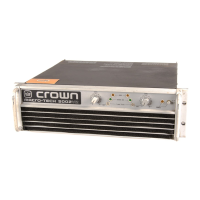
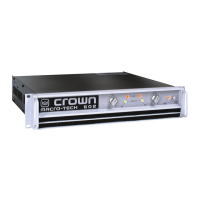
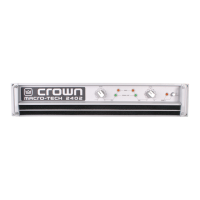

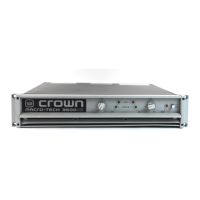
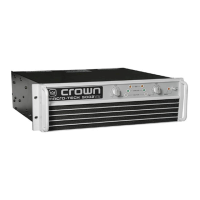
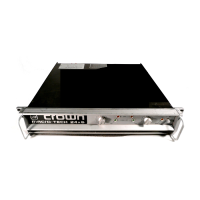
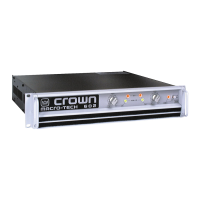
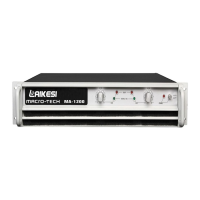
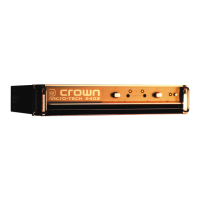
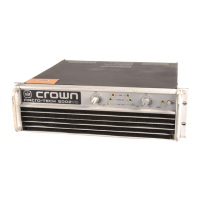
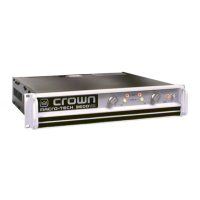
